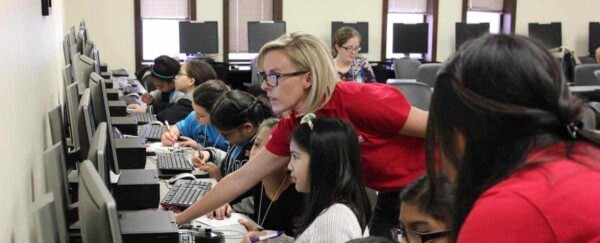CHRISTINE CATHCART, P.E., F.SWE
My experiences several years ago at the SWE national conference were brought to mind when I heard the news that the Americans with Disabilities Act was under consideration by the U.S. Supreme Court. I had arrived at that SWE conference with an injured knee, having hurt it several months earlier. Walking any distance was very slow and painful.
The first part of the trip was to get on an airplane. Being in the aerospace industry at the time, I was horrified to find how difficult it was to travel via air for anyone with a disability. I could not get the airlines to work with me on early boarding or wheelchair usage…
The hotel had an accessible room reserved for me. This room was the farthest from the elevator and had a wall that prevented a straight path to the beds or chair. This caused extra steps and there was no room for a scooter or wheelchair. I decided that since I was technically walking, this would not be a big deal. However, anyone wheelchair- or scooter-bound would have had severe problems…
As the [first] day progressed, I realized that I could not get from the hotel to the convention center in less than half an hour, even though it was right across the street. With my schedule, that was never going to work … I made the arrangements and the scooter was delivered. Now I was mobile again and having a great time until I tried to get into the room for one of the sessions. The scooter would not fit through the door. I had to leave it parked in the hall and walk into the room.
My section was selling items at the SWE Boutique that year. I went to the boutique and the sense of “what is wrong with her” came from everywhere. It is hard to see someone that had been up and walking suddenly become disabled. However, it is also hard to see people who would normally stop to talk with you walk right past you. The people who did talk, did not sit down with me. I had to look up to make eye contact. Within two hours my neck hurt, as well as my knee.
The dinners, banquets, and membership brunch turned out to be the most difficult events for me… Trying to get up onto the stage is almost impossible when a knee or hip is not working correctly. There were several times that I had to stay off the stage and do my part from the floor.
This whole experience prompted me to have the surgery to correct the knee, but also opened my eyes to the extreme difficulties that people in wheelchairs or scooters have to deal with daily. I thought of the many things that would have made the conference better for me, things that I wanted to incorporate into my interactions with people with disabilities.
There are also several challenges for the engineering community as a whole: We have the ability to create a portable stage that is accessible for all people; hotel rooms that are designed with able and disabled people in mind; scooters and wheelchairs that will fit in the trunk of a car; and convention centers with collapsible walls and doors that are wide enough for a scooter or wheelchair. Let’s put diversity into our designs as well as into our relationships with others.
FELICITA SAIEZ, F.SWE
WE19 was the fourth time that I have used a scooter at the SWE annual conference. The first time was in 2014 due to some issues with my knees, and I was so happy to have one. Though it was an adjustment, it meant that I could participate.
It has become easier to navigate the whole event, because with more experience I know what questions to ask and how to prepare. I drove to WE19, so I did not need to deal with airports this time. But when I do fly, I always use the wheelchairs that are provided. Obviously, airports and airlines are much more accommodating and aware of accessibility needs than they were 20 or more years ago. Preboarding is never a problem.
At this point, I don’t need a scooter for everyday living, but some recurring issues with my back mean I can’t walk or stand for a long time. SWE conferences have increased in size so much that even though I can do some walking, I could never get around without a scooter. At WE19 I “job shared” my scooter with SWE Past President Roberta Gleiter, F.SWE, who used it in the evenings once I returned to my hotel, and in the morning to get from her housing to our meeting place. This worked out well for both of us.
I enjoy the conferences and find that people are generally helpful when they see me on the scooter, holding the door open and being considerate. Going around the exhibits at the career fair is the most difficult part, because it is hard to talk to the booth staff from the vantage point of my scooter. And with the big crowds at some booths, I can’t even get close. The scooter is basically a big oval on the floor that keeps objects and people at a distance from me.
It’s important to know that if a scooter bumps into something or someone, chances are that the person on the scooter won’t be hurt. I am always worried about accidentally hitting someone and hurting them. Because I am tall, one-on-one conversations (aside from career fair exhibits) have not generally been a problem because we can still meet each other almost eye to eye even though I am sitting down. I also find that people will sit down next to me, grabbing a chair nearby, to talk.
SWE is wonderful for ensuring that scooters are available to members. It’s part of being inclusive, and I love SWE for it!
Christine Cathcart, P.E., F.SWE, is a project engineer IV at Honeywell in Fort Mill, South Carolina. She holds a B.S. in mechanical engineering from Kansas State University and an MBA from Maryville University. Her expertise is in test, design, systems integration, systems engineering, and project management. Active on the local and Society levels of SWE, she has held positions ranging from section officer to Society-level committee chair. She was named a SWE Fellow in 2008.
Felicita Saiez, F.SWE, recently retired as an engineering management consultant specializing in risk assessment, process improvement, and project management, and held positions including vice president, programs and services at VME Inc. A SWE member since 1977, she held numerous Society-level positions and served on the SWE board of directors as FY1999 treasurer and FY2000 vice president of education. A member of the Santa Clara Valley Section, she received the SWE Distinguished New Engineer Award in 1991, the Distinguished Service Award in 2013, and was selected as a SWE Fellow in 2004.
“Viewpoint: Then and Now: Personal Reflections on Accessibility” was written by Christine Cathcart, P.E., F.SWE, and Felicita Saiez, F.SWE. This article appears in the 2020 spring issue of SWE Magazine.
Read more from the 2020 spring issue of SWE Magazine:
- Feature: Toward More Accessible Work Environments
- Feature: Engineering for Good
- Feature: Inclusive Design for Living Longer
- Feature: Women Engineers You Should Know
- SWE Forum: From Congressional Visits to the “New Normal” Brought by COVID-19
- Opening Thoughts: Access: A Matter of Human Rights
- News & Advocacy: COVID-19: STEM Strikes Back
- News & Advocacy: Momentum, Authenticity, and Pivoting: The State of Women in Politics
- News & Advocacy: Visiting Congress During a Global Health Crisis
- News & Advocacy: People
- Career Pathways: Shelter-at-Home Orders Put Spotlight on Disability Accommodations
- President’s Note: Joy and Relevance in the SWE Mission
- Life and Work: Is Sitting the New Smoking?
- Reinvention: From Fixing up My Home to Helping Others Construct Theirs
- Media: Invisible Women: Exposing Data Bias in a World Designed for Men
- In Memoriam: Marta Kindya, 1946-2019
- Closing Thoughts: Community in Times of Crisis
- Scrapbook: Announcing a New Arrival







